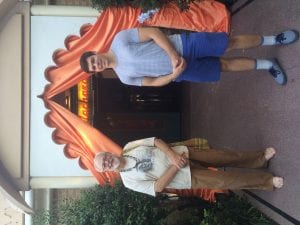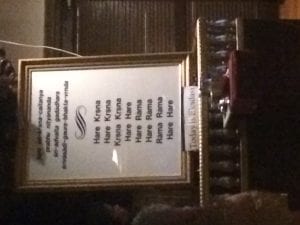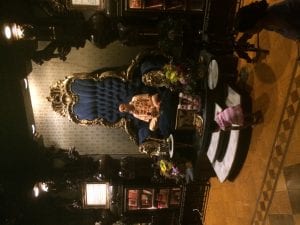“Hare Krishna Hare Krishna Hara Ram,” the sounds of a familiar chant greeted our group as we walked into the Hare Krishna temple in Dallas, Texas. The melodic chanting and playing of the instruments had me humming along on the car ride home. The instruments making the melodies were foreign to me. A little girl was playing what seemed to be a miniature version of a piano and a boy was playing some type of drum. The piano-like instrument, as our guide Prajapati happily told me, originated in England and had two components, an organ and a piano. I am not sure how it works, but I believe there is a crank on the side as well. Whatever it was, the girl was talented and the music sounded good. Along with the music there was constant chanting as the worshipers participated in a service. Although I had never been to a Hare Krishna temple before, I was familiar with the chanting through different media outlets. It made the otherwise mysterious temple a little more welcoming. Along with the chanting, a heavy aroma of incense filled the temple and pervaded my nostrils. The sounds and the scents filled the senses, and while I am not a Hare Krishna, I would like to worship in a setting like that.
Not only were the sights and sounds a pleasure, but the paintings, statues, and altar all awed me. The most intriguing aspect of the paintings were the halos around the head or sometimes heads of Krishna. The halo is a universal symbol for holiness, and it was interesting to see that every part of Krishna was depicted as holy. Even when he was at his most mischievous, getting tied up by his mother as punishment, he still had a halo around his head. The halo connects the paintings in the Hare Krishna temple to those in other churches and temples. The difference comes in the actions of Krishna when he has the halo. This difference is a major one and highlights the difference between the Hare Krishna movement and other more traditional (traditional to the average American) religions.
The movement in the United States started in New York with one man, a guru from India known as Prabhupad. He brought the religion over from India and started translating the sacred texts into English for all of his followers to read. He then taught from those readings to a group of followers that kept expanding rapidly. One person in that first group of followers was Prajapati. Prajapati talked with Prabhupad, learned from him, and held an important role in the Hare Krishna movement. He is still a devout follower and we were fortunate enough to have him lead our tour at the temple. His energy, passion, and knowledge made the whole experience much better. Not only was Prajapati welcoming, but so were all the other devotees. One of the sweetest moments was when a little girl came around with a flower and let us all smell it. I do not know the religious significance of this, but the action was heartfelt and shows the openness and kindness that characterizes the Hare Krishna followers. Unfortunately for Prajapati, I was not converted by his teaching, but I was impressed by the temple and I would like to go back and try some of the Indian food at the adjacent restaurant.
Patrick Cinelli




